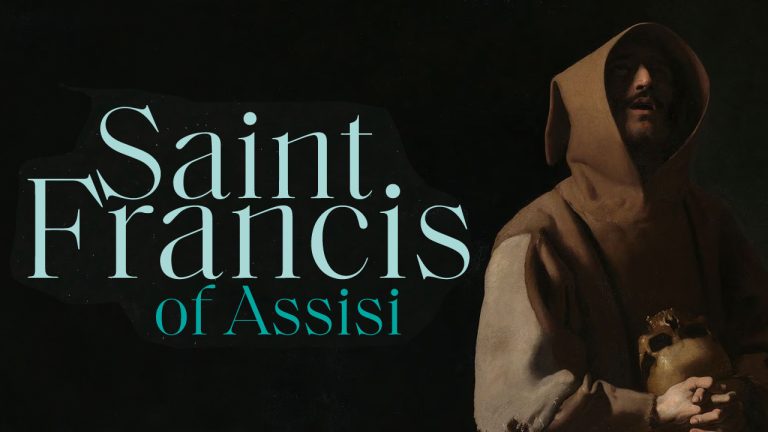Sorry, no records were found. Please adjust your search criteria and try again.
Sorry, unable to load the Maps API.
“Francis is here, to touch us again,” said Cardinal Vincent Nichols, President of the Bishops’ Conference, as he spoke at the launch event for the first major UK art exhibition to explore Saint Francis of Assisi’s life and legacy.
Exhibiting at the National Gallery in Trafalgar Square until 30th July, the art and imagery of Saint Francis (1182–1226) from the 13th century to today, brings together paintings from the gallery’s collection by Sassetta, Botticelli, and Zurbarán with international loans including works by Caravaggio, Josefa de Óbidos, Stanley Spencer, Antony Gormley, Giuseppe Penone, Andrea Büttner, and an exciting new commission from Richard Long.
From some of the earliest medieval panels, relics and manuscripts to modern-day films and a Marvel comic, the exhibition shines a light on how Saint Francis has captured the imagination of artists through the centuries, and how his appeal has transcended generations, continents and different religious traditions.
“Francis of Assisi enjoys astonishing and continuing popularity,” said Cardinal Nichols. “His love of and care for creation is often what opens for many the pathway of a deeper appreciation of this remarkable saint.”
The Cardinal pointed out that St Francis’s love of the natural world was never romantic:
“Francis chose to leave his inherited comforts and identify with those at the mercy of the elements, those closest to the realities of nature: the lepers, the poor, the outcast. He suffered with them, often soaked to the skin and frozen to the marrow. Yet he sang to the glory of God seen and experienced in the features of the created world. The way of radical poverty and vulnerability that he chose is made clear by one look at his tunic, a precious relic kindly brought here from Florence.”
Full Address
Ladies and Gentlemen,
I am deeply honoured to be invited to speak at this reception marking the launch of this remarkable exhibition.
Francis of Assisi enjoys astonishing and continuing popularity. His love of and care for creation is often what opens for many the pathway of a deeper appreciation of this remarkable saint.
Yes, his love of, and care for, the natural world is very contemporary. But it was never romantic. Francis chose to leave his inherited comforts and identify with those at the mercy of the elements, those closest to the realities of nature: the lepers, the poor, the outcast. He suffered with them, often soaked to the skin and frozen to the marrow. Yet he sang to the glory of God seen and experienced in the features of the created world. The way of radical poverty and vulnerability that he chose is made clear by one look at his tunic, a precious relic kindly brought here from Florence.
As Ann Roe wrote in her excellent review of this exhibition: ‘Francis is no easy saint. But through him we can also discover, if we are inclined to, the preciousness of everyday wonders: of water, rocks and stars, of herbs and creatures, and of divinity moving in them, as it moves also in us.’
Francis took this ‘movement of God’ to deeply controversial dimensions in many things that he did. One we can see here is his reaching out to Islam, at that time the faith of the invaders of the holy places. In a lull in the endless battles of the Crusades, in 1219, he came face to face with the great Islamic ruler, Sultan Malik al-Kamil at Damietta in Egypt. The content of their meeting is not known, other than that it led to a deep respect between the two men of different religions and, quite remarkably, the safe return of Francis to Christian lines.
In this exhibition, we also meet Clare of Assisi. In doing so please remember that thirteenth-century Europe was awash with women’s movements – women struggling to establish their own initiatives and spaces. Clare’s mother, Ortolana, went on a women-only pilgrimage to the Holy Land. Clare fought all her life for the right for her sisters to risk all and live in total poverty without male protection. This Privilegium paupertatis was finally granted to her in the last days of her life. She never gave up and she is properly considered, in my view, to be the great and first protector of the radical depth of the Franciscan charism.
The call of Francis first came to him through the Cross of Christ, in the little Church of San Damiano. Gradually it became clear to Francis that the words ‘rebuild my church’ did not mean the stones and wood of San Damiano, but the spiritual fabric of the entire Church. He took that rebuilding back to the deepest foundations – to the radical identity of the disciple with the Beloved Master, who, in his total obedience, gave himself up to death, even death on a cross.
Here in the exhibition, we have a glimpse into the agony which filled the heart of Francis. Daily, in the later part of his life, he carried the constant pain of the stigmata, the burning into his flesh of the wounds of Christ, in his side, hands and feet, wounds which rendered him barely able to walk, even when helped by the shoes fashioned for him by Clare. Yet also we glimpse the ecstasy which he experienced in prayer and contemplation, an ecstasy that filled him with joy, yet left him hungering for more.
Many years ago now I took a group of teenagers to Assisi. They were wonderful: anarchic, spontaneous and great-spirited. But they were utterly bowled over by Assisi: the natural beauty of the early morning valley laced with mist, the uncompromising harshness of the bed of bare rock where Francis slept, the challenge that he threw at them to be authentic and bold in their Catholicism. When we came to his tomb, in the crypt of the Basilica, they unashamedly wept.
The call of Francis is as clear today as it was to those youngsters, as it has been across the centuries. I thank most sincerely all who have helped to bring this Exhibition to London, to the National Gallery. Francis is here, to touch us again.
Cardinal Vincent Nichols
President of the Bishops’ Conference
Archbishop of Westminster
________________
SOURCE:
![]()




























